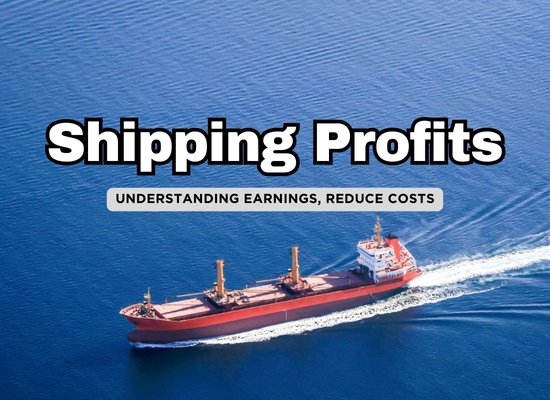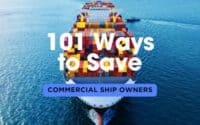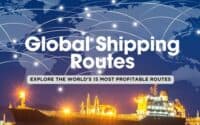Voyage Profitability: How to Accurately Calculate and Maximize Your Profits

On the face of it, it can be easy to assume a voyage is profitable if freight rates are strong and fuel costs are manageable. But beneath the surface, hidden expenses—crew wages, maintenance, port fees, and unexpected delays—can quietly eat into margins. Even seasoned professionals can overlook critical cost factors, and for those new to the industry, understanding true profitability is even more challenging.
This guide breaks down the real economics of voyage profitability, helping both experienced operators and those considering entering the space make informed decisions. With practical insights and a detailed profitability calculator, you’ll get a clear picture of what it takes to run a financially successful voyage.
🧮 Article Contains ShipUniverse Maritime Calculators
** This calculator provides estimated voyage profitability based on user-entered data. Actual results may vary due to unforeseen costs, market fluctuations, and operational factors. Users should verify calculations with their own financial analysis before making decisions. **
ShipUniverse: Voyage Profitability Calculator
| Voyage Distance (NM): | |
| Voyage Duration (Days): | |
| Ship Type: | |
| Ship Age (Years): | |
| Fuel Consumption (Tons/Day): | |
| Fuel Price per Ton ($): | |
| Crew Wages per Day ($): | |
| Cargo Volume (TEUs or Tons): | |
| Freight Rate per Unit ($): | |
| Annual Insurance Cost for Vessel($): | |
| Annual Maintenance Cost for Vessel($): | |
| Net Profit: - | Break-even Rate: - | |
📊 Understanding the Profitability Formula 📊
Voyage profitability isn’t just about high freight rates—it’s a balance of revenue, fixed costs, and variable expenses. Many shipowners focus on freight income while underestimating operational costs that can erode margins or even turn a voyage unprofitable. Here’s a breakdown of the key components of the profitability equation:
1️⃣ Revenue: The Starting Point
- Freight Rate × Cargo Volume → The core income from each voyage.
- Example: A 50,000 DWT bulk carrier charging $20 per ton for cargo generates $1M in revenue, but this is before deducting costs.
- Influenced by market demand, contract terms, and seasonal trends (e.g., grain exports spiking in certain months).
2️⃣ Fixed Costs: The Baseline Expenses
These costs remain constant whether a ship is actively sailing or sitting idle:
- Depreciation → A vessel typically loses 3-5% of its value per year, impacting long-term financial planning.
- Crew Wages & Benefits → Crew salaries, insurance, food, and travel costs. A mid-sized cargo ship’s crew can cost $15,000–$30,000 per month.
- Loan Repayments & Insurance → Monthly payments for financing the ship and hull/P&I insurance, which varies based on vessel type, age, and risk factors.
3️⃣ Variable Costs: The Profit Killers
These fluctuate per voyage and can drastically impact profitability:
- Fuel Consumption & Price Fluctuations → Fuel can make up 50–70% of a voyage’s total costs. A Panamax bulk carrier burning 30 tons of fuel daily at $600 per ton spends $18,000 per day.
- Port & Canal Fees → Suez and Panama Canal fees can be six figures per transit, while smaller ports may have high congestion charges.
- Maintenance & Repairs → Routine upkeep (dry docking, surveys) and emergency breakdowns. Unplanned engine failures can cost hundreds of thousands in delays and repairs.
4️⃣ The Final Equation: True Profitability
📌 Net Profit = Revenue - (Fixed Costs + Variable Costs)
Even when freight rates are favorable, failing to control these costs can turn a profitable-looking voyage into a financial drain. The key is understanding cost drivers, optimizing operations, and using smart financial planning to increase margins and long-term sustainability.
📊 Key Cost Drivers That Impact Your Bottom Line 📊
Voyage profitability is heavily influenced by several key cost factors, many of which fluctuate based on market conditions, ship type, and operational decisions. Controlling these costs is essential to maximizing margins and avoiding unexpected financial setbacks. Below are the biggest cost drivers shipowners must monitor:
1️⃣ Fuel Costs & Efficiency
- Largest variable expense—often 50-70% of total voyage costs.
- Price volatility makes budgeting unpredictable (e.g., $400/ton vs. $700/ton drastically changes profit margins).
- Solutions to reduce fuel costs:
✅ Slow steaming – Reducing speed can cut fuel consumption by up to 30%.
✅ Hull cleaning & propeller polishing – A fouled hull increases fuel burn.
✅ Route optimization – Avoiding strong currents and adverse weather minimizes fuel waste.
2️⃣ Port & Canal Fees
- Major cost factor, especially for high-traffic routes.
- Examples:
- Suez Canal fees for a Panamax bulk carrier: $300,000+ per transit.
- Port congestion fines: Delays at major ports can cost $25,000+ per day.
- Ways to reduce costs:
✅ Pre-book slots at congested ports to avoid high waiting fees.
✅ Consider alternative, less congested ports when feasible.
✅ Negotiate bulk discounts for frequent port use.
3️⃣ Crew Wages & Labor Costs
- Fixed cost, but a major factor in long-term profitability.
- Example: A mid-size cargo ship’s crew costs $15,000–$30,000 per month.
- Additional expenses:
- Overtime pay during port delays.
- Travel expenses for crew changes.
- Training and compliance costs.
- Cost-control strategies:
✅ Optimized crew scheduling to reduce overtime and extra travel costs.
✅ Technology & automation to reduce crew requirements.
✅ Prevent turnover – Retaining trained crew minimizes recruitment costs.
4️⃣ Ship Maintenance & Depreciation
- Annual dry-docking & maintenance costs: Required every 5 years, costing hundreds of thousands to millions depending on vessel size.
- Unexpected repairs can cripple a voyage’s profitability—engine failures can cost $500,000+ in delays and repairs.
- Depreciation Impact:
- Ships lose 3-5% of their value per year, affecting resale and refinancing options.
- Best practices:
✅ Regular preventative maintenance minimizes major failures.
✅ Using real-time ship health monitoring can detect issues before they become expensive.
5️⃣ Insurance & Compliance Costs
- Protection & Indemnity (P&I) insurance, hull insurance, and war risk coverage are essential but costly.
- Factors affecting insurance costs:
- Ship age → Older ships have higher premiums.
- Operating region → High-risk piracy zones increase costs.
- Claims history → Frequent incidents mean higher rates.
- Ways to control insurance expenses:
✅ Maintaining a clean safety record to negotiate better rates.
✅ Implementing risk-reducing technology (e.g., fuel monitoring, hull sensors).
✅ Joining maritime risk pools for discounted coverage.
6️⃣ Market Fluctuations & Freight Rates
- Freight rates are cyclical and unpredictable.
- Example: A 40,000 DWT bulk carrier might earn $20,000/day in peak seasons but drop to $8,000/day in downturns.
- How to mitigate risk:
✅ Diversify cargo contracts → Secure long-term freight agreements.
✅ Stay ahead of market trends → Use analytics to predict downturns.
✅ Leverage ship flexibility → Adapt vessel use based on demand (e.g., switching from dry bulk to containers).
Understanding and optimizing these cost drivers directly impacts profitability. Even a small percentage saved on fuel, crew, or maintenance can mean millions in annual savings. Shipowners who actively manage these costs will consistently outperform competitors in both profitability and long-term sustainability.
📊 Strategies to Increase Voyage Profitability 📊
Maximizing voyage profitability isn’t just about reducing costs—it’s about making smart operational and financial decisions that optimize earnings, minimize inefficiencies, and leverage market conditions. Below are proven strategies that shipowners and operators can use to boost their margins and ensure long-term success.
| ShipUniverse: Strategies to Increase Voyage Profitability | ||
| Strategy | Why It Works | How to Implement |
| Optimize Fuel Efficiency | Fuel is the single largest cost per voyage. Even a small reduction in consumption significantly boosts margins. |
- Reduce speed where feasible to save fuel - Keep the hull and propellers clean to minimize drag - Use fuel monitoring systems to track and optimize usage - Explore LNG or hybrid fuel options for long-term cost savings |
| Reduce Port & Canal Costs | High port and canal fees can erode profits quickly, especially in congested areas. |
- Pre-book berths to avoid long waits and fees - Choose less congested ports with lower handling costs - Negotiate volume discounts for frequent port use - Optimize scheduling to avoid peak congestion periods |
| Improve Cargo Utilization | Maximizing cargo space ensures higher revenue per voyage. |
- Balance cargo weight and distribution for efficiency - Reduce empty backhaul voyages by securing return cargo - Use flexible cargo handling to accommodate different freight types - Optimize stowage planning to eliminate wasted space |
| Lower Crew Costs Without Sacrificing Performance | Crew wages, benefits, and provisions are fixed costs that impact long-term profitability. |
- Adjust crew scheduling to minimize unnecessary overtime - Implement automation to reduce operational workload - Retain experienced crew to avoid frequent recruitment costs - Cross-train crew for multiple roles to improve efficiency |
| Use Data & Technology for Smarter Decisions | Technology helps identify inefficiencies and optimize key cost areas. |
- Use voyage analytics to track cost patterns and trends - Implement predictive maintenance to reduce repair costs - Monitor real-time freight rates for better contract negotiations - Invest in AI-based route optimization to minimize delays and fuel use |
| Smart Financing & Insurance Management | Optimizing financial strategies reduces long-term financial strain. |
- Lease ships instead of buying to maintain financial flexibility - Join maritime insurance pools to lower premium costs - Improve safety records to negotiate better insurance rates - Explore carbon credit incentives for greener vessel operations |
| Diversify Revenue Streams | Exploring additional income sources beyond freight rates improves financial stability. |
- Lease unused deck space for specialized cargo transport - Offer chartering services when cargo demand is low - Adapt to emerging markets, such as renewable energy cargo - Provide logistics and supply chain consulting for extra revenue |
Many voyages that appear profitable on the surface can quickly turn into financial drains when hidden expenses—like fuel price volatility, port delays, or unexpected maintenance—are factored in. That’s why understanding the real cost structure of a voyage is critical.
The strategies in this guide provide actionable steps to help shipowners and stakeholders measure, manage, and increase their profit margins. Now, it’s time to take action and implement the most impactful changes.
📌 Action Plan for Shipowners: Next Steps
✅ Step 1: Assess Your Current Profitability
- Use the Voyage Profitability Calculator to get a real-time financial breakdown of your voyages.
- Identify key cost areas where margins are being eroded.
✅ Step 2: Optimize Fuel & Operational Efficiency
- Implement slow steaming where applicable and use AI-based route optimization tools.
- Maintain a clean hull and propellers to reduce unnecessary drag.
- Explore fuel hedging or alternative energy solutions for long-term cost savings.
✅ Step 3: Reduce Port, Canal, and Cargo Handling Costs
- Pre-book port berths to avoid congestion and late fees.
- Research alternative, cost-effective ports for potential savings.
- Ensure efficient cargo loading and unloading to reduce layover times.
✅ Step 4: Leverage Data & Technology
- Use voyage analytics to track trends and find inefficiencies.
- Implement predictive maintenance to reduce unexpected repair costs.
- Monitor real-time freight rates to lock in the best contracts.
✅ Step 5: Diversify Revenue & Strengthen Financial Management
- Look for chartering opportunities or alternative cargo types to maximize vessel utilization.
- Join insurance risk pools to reduce premiums.
- Explore carbon credit programs or other financial incentives for eco-friendly shipping.
✅ Step 6: Continuous Monitoring & Adjustment
- Regularly review voyage data to adapt to changing market conditions.
- Keep an eye on fuel prices, insurance rates, and emerging cargo markets.
- Train crew and staff on cost-saving techniques and operational efficiency.
Every voyage is an investment. By applying the right cost-cutting strategies and efficiency improvements, shipowners can turn a good voyage into a great one—and keep their fleet operating profitably in both stable and volatile markets.
The question isn’t just whether your ship is moving—it’s whether it’s moving profitably. Now is the time to run the numbers, take control of hidden costs, and maximize your voyage returns.

Do you have a Maritime Product or Service that may be of interest to Shipowners? Tell us about it here!
Do you have feedback or insights? Please reach out to editor @ shipuniverse.com



